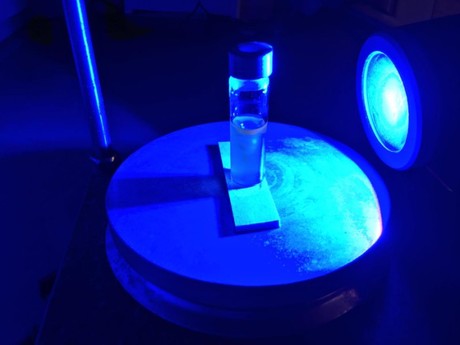Creating radioactive molecules with photocatalysts

Princeton University researchers have pioneered a revolutionary new way of creating radioactive molecules. Led by Professor David MacMillan and published in the journal Science, their work has the potential to bring new medicines to patients much faster than before.
Every new medication has to go through testing to confirm that it affects the part of the body it is intended to affect. As noted by Professor MacMillan, “Is it going to the right place? The wrong place? The right place and the wrong place?”
Tracing the path of a chemical that dissolves into the bloodstream used to present a serious challenge — one that radiochemists solved some years ago by swapping out individual atoms with radioactive substitutes. Once that is done, “the properties of the molecule — of the drug — are exactly the same except that they’re radioactive, and that means that you can trace them really, really well”, Professor MacMillan explained.
Unfortunately, this introduced a new problem: how to get the radioactive atoms into the drug in the first place.
“[This] is not a trivial thing to do,” Professor MacMillan said. “People have developed long, sometimes month-long, two-month, three-month-long sequences just to get a tiny amount of a substance with a few radioactive atoms.”
Now, Professor MacMillan and his colleagues have found another way, drawing on their work using blue LED lights and catalysts that respond to light, known as photocatalysts. “What we came up with was,” Professor MacMillan said, “if you shine light on them, and you have a photocatalyst, could these photocatalysts actually remove the non-radioactive atom and then install the radioactive atom?”
It was a “wacky idea”, Professor MacMillan admitted — but it actually worked.
The technique uses ‘heavy water’, which replaces the hydrogen (H) in H2O with tritium, a radioactive version of hydrogen that has an extra two neutrons per atom. As explained by Professor MacMillan, “If you just let your drug sit in the radioactive water and shine light on it with a catalyst, the catalyst will remove the atom which is not radioactive — in this case, hydrogen — and replace it with tritium.”
Attaching one of these atomic labels takes hours instead of months, and the technique works on many kinds of frequently used compounds. The researchers have already tested it on 18 commercially available medicines, as well as candidates in the Merck drug discovery pipeline.
For compounds that don’t need radioactive tags, the same one-step process can swap in deuterium, a version of hydrogen with only one extra neutron. These ‘stable labels’ (with deuterium) and ‘radio labels’ (with tritium) have countless applications, in academia as well as drug discovery.
The simplicity of this new approach has another implication, according to Jennifer Lafontaine from pharmaceutical company Pfizer, who was not involved in the research. Because the previous process was so resource intensive, deuterium- or tritium-labelled molecules were often only created for chemicals that were “quite advanced in the drug discovery process”, she said.
“This methodology could therefore open the door to earlier and expanded use of isotopic labelling in drug discovery, significantly enhancing our ability to study drug candidates on a deeper level and across a range of applications,” said Lafontaine, who is senior director of synthesis and analytical chemistry for Pfizer.
The technology was developed in collaboration with Merck at Princeton’s Merck Catalysis Center, where Princeton graduate student Yong Yao Loh and postdoctoral researcher Kazunori Nagao conducted research using the radioactive material. Professor MacMillan has dismissed suggestions that the process will be patented, saying “we want it to be available for everyone to use”.
“Your average drug takes 12 to 14 years to come to market,” said Professor MacMillan. “So everything that we can do to take that 14- or 12-year time frame and compress it is going to advantage society, because it gets medicines to people — to society — so much faster.”
Benchtop NMR used to assess heart disease risk
The breakthrough will enable more accessible, high-throughput cardiovascular disease (CVD) risk...
Activated gold helps visualise drug movement in the body
Gold nanoparticles are promising drug carriers for cancer therapy and targeted drug delivery, but...
Plasma-modified graphene enhances gas sensors
Researchers have improved gas-sensing technology by treating graphene sheets with plasma under...




